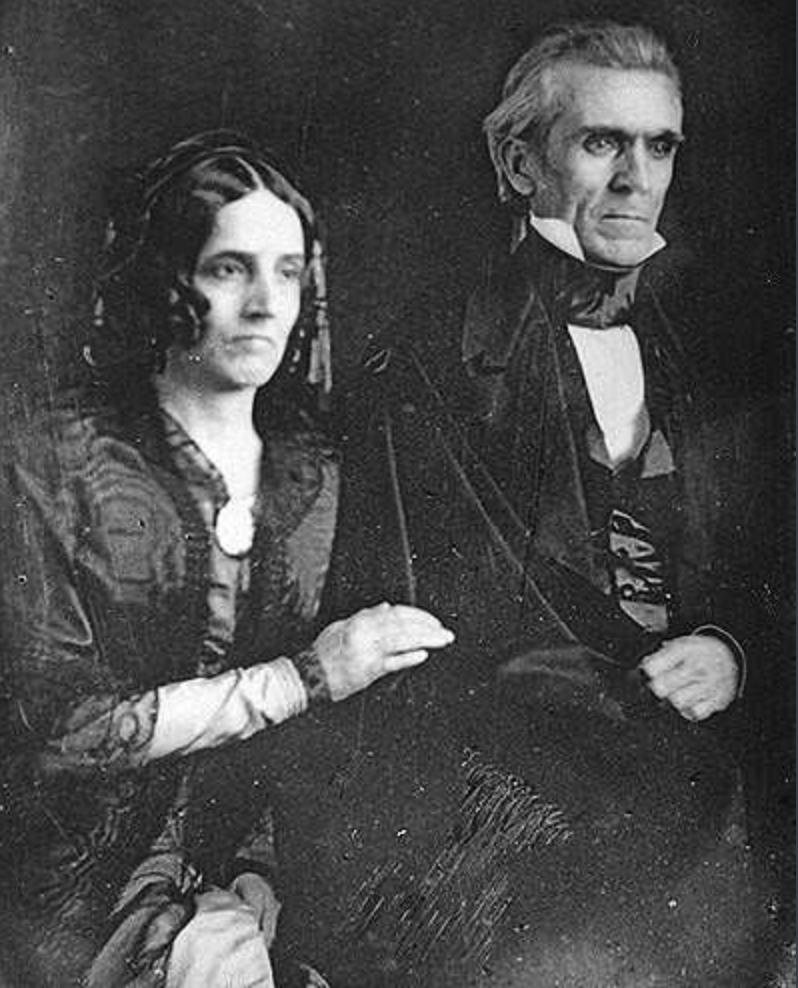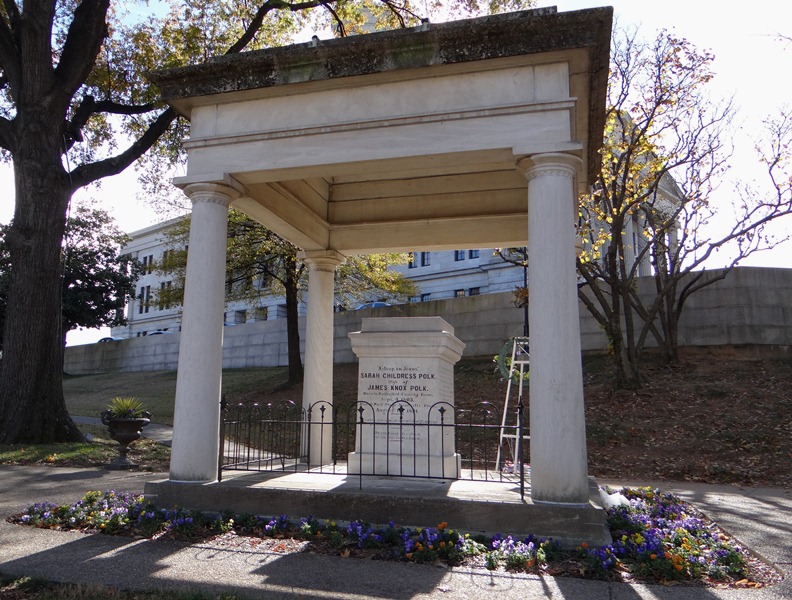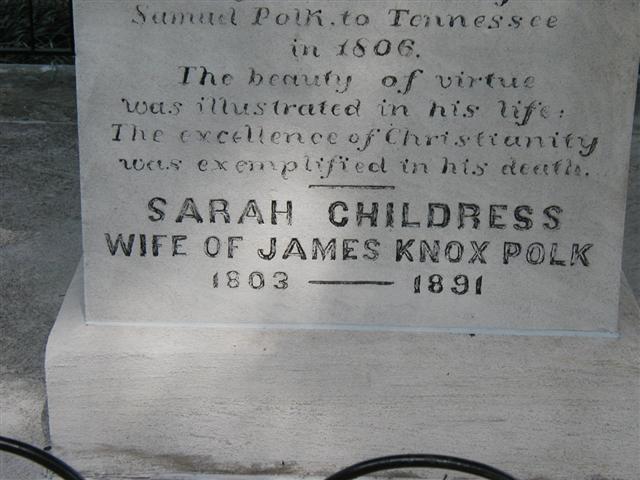United States First Lady. She was the wife of James K. Polk, the 11th President of the United States. Born on a plantation near Murfreesboro, Tennessee, she was the oldest daughter of Captain Joel and Elizabeth Childress, a prosperous slave-owning planter and merchant. She and her sister were educated in a private school in Nashville before the Moravians' Female Academy at Salem, North Carolina, which was one of the few female institutions of higher learning in the early 19th century. During this time, she was taught to be a wife of a man with a political career. On January 1, 1824, she married James K. Polk, an ambitious Jacksonian politician. The couple never had children. Her husband's political career began in the Tennessee House of Representatives before going to Washington D.C. in 1825 to serve in the House of Representatives, becoming Speaker between 1835 and 1839. Her husband was chairman of Ways and Means Committee and supported demolishing the corrupted Federal Bank. Returning to Tennessee, her husband was the 9th Governor of Tennessee, serving from October 14, 1839 to October 15, 1841, but lost the election for the same office in 1841 and 1843. With a stance on states' rights and western expansion of the United States or Manifest Destiny, her husband was a candidate in 1844 for the office of the President of the United States, serving from March 4, 1845 to March 4, 1849. On May 13, 1846, the United States Congress declared war on Mexico after a request from President James K. Polk and on May 26, 1848, the Mexican War ended with other western territories eventually becoming part of the United States. Having an active and powerful role in her husband's presidency, she acted as his personal secretary as well as the hostess of the White House. She did little to remodel the White House. As a strict Presbyterian, she did not allow music with dancing, singing, card playing, gambling, or alcohol in the White House. She did not support the women's right to vote. She had the first traditional Thanksgiving day dinner in the White House, and Sunday was always a day of rest. Upon leaving the White House, the couple traveled throughout the South, attending numerous parties before relocating to a new home in downtown Nashville, "Polk Place." Three months after leaving the White House, her husband died during a cholera epidemic at age 53 and was first buried in the city cemetery, but later re-interred on the grounds of their estate. Wearing black, she remained as his widow for over forty-two years. In 1850, her motherless great-niece, Sarah "Sallie" Polk Jetton, the granddaughter of her oldest brother, came to live with her at Polk Place. She exercised her business sense while a widow. She had inherited slaves from her father and husband to manage her household as well as her half-interest in a cotton plantation near Yalobusha, Mississippi. Her niece married George Fall in 1865 in the parlor at Polk Place, and the couple stayed until their first child was born three years later. During the American Civil War, both sides respected her neutrality as a former First Lady with her entertaining officers from both armies and later after the war, President Hayes and Mrs. Hayes and President Cleveland and Mrs. Cleveland. Several of her slaves on the Mississippi plantation joined the Union Army in 1863. Upon her death, she was buried next to her husband for a short time. Eventually, Polk Place became neglected, was sold, and then demolished by 1901. After the property was sold, the couple's remains were re-interred on the grounds of the Tennessee State Capitol in 1893. Although it was never her home, her husband's ancestral home in Columbia is considered the President James Polk Home and Museum.
United States First Lady. She was the wife of James K. Polk, the 11th President of the United States. Born on a plantation near Murfreesboro, Tennessee, she was the oldest daughter of Captain Joel and Elizabeth Childress, a prosperous slave-owning planter and merchant. She and her sister were educated in a private school in Nashville before the Moravians' Female Academy at Salem, North Carolina, which was one of the few female institutions of higher learning in the early 19th century. During this time, she was taught to be a wife of a man with a political career. On January 1, 1824, she married James K. Polk, an ambitious Jacksonian politician. The couple never had children. Her husband's political career began in the Tennessee House of Representatives before going to Washington D.C. in 1825 to serve in the House of Representatives, becoming Speaker between 1835 and 1839. Her husband was chairman of Ways and Means Committee and supported demolishing the corrupted Federal Bank. Returning to Tennessee, her husband was the 9th Governor of Tennessee, serving from October 14, 1839 to October 15, 1841, but lost the election for the same office in 1841 and 1843. With a stance on states' rights and western expansion of the United States or Manifest Destiny, her husband was a candidate in 1844 for the office of the President of the United States, serving from March 4, 1845 to March 4, 1849. On May 13, 1846, the United States Congress declared war on Mexico after a request from President James K. Polk and on May 26, 1848, the Mexican War ended with other western territories eventually becoming part of the United States. Having an active and powerful role in her husband's presidency, she acted as his personal secretary as well as the hostess of the White House. She did little to remodel the White House. As a strict Presbyterian, she did not allow music with dancing, singing, card playing, gambling, or alcohol in the White House. She did not support the women's right to vote. She had the first traditional Thanksgiving day dinner in the White House, and Sunday was always a day of rest. Upon leaving the White House, the couple traveled throughout the South, attending numerous parties before relocating to a new home in downtown Nashville, "Polk Place." Three months after leaving the White House, her husband died during a cholera epidemic at age 53 and was first buried in the city cemetery, but later re-interred on the grounds of their estate. Wearing black, she remained as his widow for over forty-two years. In 1850, her motherless great-niece, Sarah "Sallie" Polk Jetton, the granddaughter of her oldest brother, came to live with her at Polk Place. She exercised her business sense while a widow. She had inherited slaves from her father and husband to manage her household as well as her half-interest in a cotton plantation near Yalobusha, Mississippi. Her niece married George Fall in 1865 in the parlor at Polk Place, and the couple stayed until their first child was born three years later. During the American Civil War, both sides respected her neutrality as a former First Lady with her entertaining officers from both armies and later after the war, President Hayes and Mrs. Hayes and President Cleveland and Mrs. Cleveland. Several of her slaves on the Mississippi plantation joined the Union Army in 1863. Upon her death, she was buried next to her husband for a short time. Eventually, Polk Place became neglected, was sold, and then demolished by 1901. After the property was sold, the couple's remains were re-interred on the grounds of the Tennessee State Capitol in 1893. Although it was never her home, her husband's ancestral home in Columbia is considered the President James Polk Home and Museum.
Bio by: Linda Davis
Inscription
Asleep in Jesus
Wife of James Knox Polk
Died at Polk Place
"A noble woman, a devoted wife, a true friend, a sincere Christian"
"Blessed are the dead which die in the Lord.
Gravesite Details
Originally buried at Polk Place
Family Members
Advertisement
See more Polk or Childress memorials in:
Records on Ancestry
Sponsored by Ancestry
Advertisement













